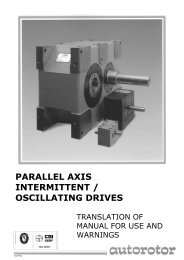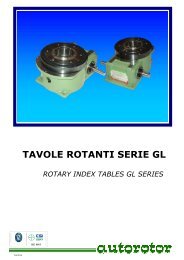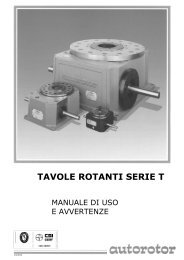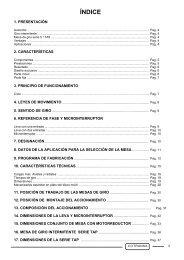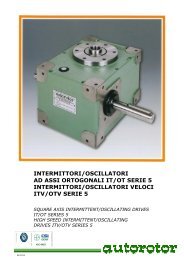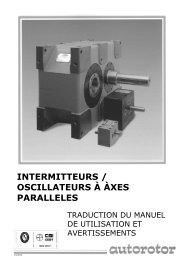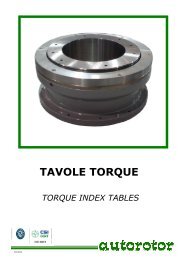TAVOLE ROTANTI SERIE TA - Autorotor Srl
TAVOLE ROTANTI SERIE TA - Autorotor Srl
TAVOLE ROTANTI SERIE TA - Autorotor Srl
You also want an ePaper? Increase the reach of your titles
YUMPU automatically turns print PDFs into web optimized ePapers that Google loves.
L’esperienza diretta come utilizzatori del nostro<br />
stesso prodotto, naturalmente supportata dalla<br />
teoria e dal calcolo, ci ha guidato nella scelta<br />
delle leggi di movimento più adatte:<br />
CICLOIDALE oppure SINUSOIDALE (a)<br />
Per la sua tendenza a non dare luogo a sensibili<br />
vibrazioni, questa legge può considerarsi la<br />
migliore.<br />
SINUSOIDALE DEVIA<strong>TA</strong> oppure MODIFICA<strong>TA</strong><br />
(b)<br />
E’ ottenuta dalla curva ad andamento<br />
sinusoidale ma con coefficiente di accelerazione<br />
più basso; presenta rispetto alla prima, un<br />
passaggio più dolce dalla massima<br />
accelerazione alla minima decelerazione.<br />
TRAPEZOIDALE MODIFICA<strong>TA</strong> (c)<br />
E’ una derivazione della cicloidale.<br />
Tra le curve che abbiamo normalizzato è quella<br />
che ha il coefficiente di accelerazione più basso.<br />
SINUSOIDALE MODIFICA<strong>TA</strong> con tratto a<br />
velocità costante (d)<br />
E’ simile alla sinusoidale modificata ma<br />
possiede un periodo a velocità costante.<br />
Variando la percentuale a velocità costante<br />
dell’angolo di trasferimento, varia il coefficiente<br />
di accelerazione.<br />
8 Rotary index tables series <strong>TA</strong><br />
LEGGI DI MOVIMENTO<br />
MOTION LAWS<br />
Our direct experience as users of our product,<br />
naturally backed by theory and calculation, has<br />
led us to select the suitable motion laws.<br />
They are:<br />
CYCLOIDAL or SINUSOIDAL (a)<br />
It is considered the best one, as no<br />
considerable vibrations are generated.<br />
SINUSOIDAL DEVIATED or MODIFIED(b)<br />
It stems from the sinusoidal cerve but has a<br />
lower acceleration coefficent, this turns out in a<br />
smoother passage from maximum acceleration<br />
to maximum decelation.<br />
TRAPEZOIDAL MODIFIED (c)<br />
It derives from the cycloidal one<br />
It has the lowest acceleration coefficent among<br />
the curves we have normalized.<br />
SINUSOIDAL MODIFIED with a stretch at<br />
constant speed (d)<br />
This motion law is similar to the sinusoidal<br />
modified one, but has a period at constant<br />
speed. Varying the percentage of the indexing<br />
angle at constant speed, the acceleration<br />
coefficent varies consequently.<br />
DIAGRAMMI DELLE LEGGI DI MOTO<br />
MOTION LAWS DIAGRAMS




